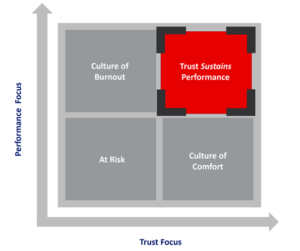Why spend valuable time and other resources espousing, creating and building a high trust culture? The answer is relatively simple, it’s that high trust sustains high performance. Consider the following statistics from Great Places to Work:
- Employees who are committed and engaged at work are 87% less likely to leave their current company.
- Organizations with engaged employees outperform those with low employee engagement by 202%.
- The GPTW 100 Best companies have outperformed the overall market by a factor of nearly 3X.
- Companies with engaged workforces have 5 times higher shareholder returns over 5 years.
In the chart above, it is clear that the Low Trust/ Low Performance cultures are in danger of closing their doors. They will likely experience difficulty in attracting and retaining employees and those that do remain will be operating at a third of what their highly engaged counterparts are giving. No company can sustain this environment for long.
A High Performance/ Low Trust culture may seem like it isn’t that bad, until you look closely. The high performance is being given not out of a desire to achieve meaningful results, but out of a desire to avoid negative repercussions. High performance cultures may attract employees, but the retention suffers. Employees quickly realize that it is an eat what you kill environment where no one has their back. These cultures have often times not spent the requisite time to develop and articulate a “Why” or a “Purpose”. Employees may work exceptionally hard for a period of time, but without feeling like they are working toward something, will quickly burn out and move on to more meaningful opportunities.
A High Trust/ Low Performance culture may seem attractive from an employee point of view and likely will not have too much difficulty attracting employees, but the employees who are comfortable in these cultures are not of the driven to succeed mentality. Fairly soon, they whole company falls into a state of mediocrity because there is no one willing to push the boundaries, no one is driving the business forward and everything remains status quo, a recipe for a painful organizational death in a world where technology has moved at warp speed.
The ideal culture is one that is founded on High Trust and High Performance. Neuroscientific research shows that trust reduces social frictions and promotes cooperative behavior among colleagues — and that managers can create high-trust, high-performance teams. Research has revealed organizational trust as a key part of culture that directly influences how willing your employees are to go above and beyond in their roles. Frictions naturally occur when humans collaborate, but at the same time, our brains are built to work in teams so there is a tension between wanting to be a team member and seeking to avoid conflicts with others by avoiding other humans. Research on the neuroscience of trust has shown that trust acts as a social lubricant, reducing social frictions so working with others is easier, more efficient, and more enjoyable. And when people work more effectively together, productivity and innovation levels rise.
Building a high trust environment is not only good for your employees, but also for your business!
